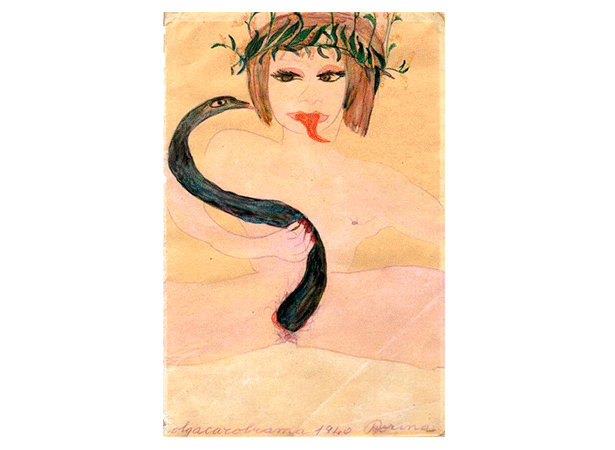The Passion According To Carol Rama
31 October 2014–22 February 2015
Museu d’Art Contemporani de Barcelona
Plaça dels Àngels, 1
08001 Barcelona
Spain
With a selection of 200 works, the exhibition The Passion According to Carol Rama is the largest of the artist’s work to date. Born in 1918 in Turin, Carol Rama—never academically trained or explicitly faithful to any particular movement—developed a body of work over seven decades that is as unique as it is obsessive. The artist experimented with alternative materials, developing techniques for inventing new bodies and elaborating cartographies of dissident desire.
Ignored for decades by official history of art discourses—yet now essential for understanding the mutations of contemporary art and the work of posterior artists such as Cindy Sherman, Kara Walker, Sue Williams, Kiki Smith and Elly Strik—the work of Carol Rama distorts the dominant history of 20th-century art and returns today like a phantom limp to interpolate our gaze and provoke alternative narratives. Divided into four thematic sections, the exhibition proposes a guide through the artist’s various creative moments.
Political anatomy
The early work of Carol Rama, made when she was just 20 years old, is inscribed with the experiences of institutional confinement and death. The watercolour figures of this period were censored as “obscene” by the Italian government of 1945—a probable reason behind the artist’s abandonment of figurative modes. These works make visible a body that questions fascism’s heroic ideals of health and virtue. The artist invents her own visual grammar that also confronts modernism’s representations of sexuality: here is a body that is mutilated and threatening, violated and undeniably desiring. A female, sick or disabled body is presented as both active and vital.
Organic abstraction
Throughout the 1950s, Carol Rama abandoned figurative modes of working and became briefly involved with the Concrete Art Movement. In the ’60s the artist moved towards Informalism and Spacialism with the creation of what the writer Edoardo Sanguineti would label “bricolage”: organic maps made from taxidermy eyes, fingernails, mathematical symbols, syringes and electrical circuits. The Bricolages can be seen as material translations of the poetic experiments of the Novissimi movement, the Cronogrammi of Nanni Balestrini or the cut-ups of William Burroughs.
Well made but vulnerable organisms
Carol Rama has worked with rubber from bicycle tires since the end of the ’70s. The material is tied to her biography: her father had a bicycle factory in Turin. Rama treats rubber like a taxidermist model’s skin—the artist dissects the tires and substitutes paint and the brush for different textures and forms of rubber. Punctured, flaccid, decomposing and aged by light and time, Rama’s rubber tires are like our bodies: vulnerable material transformed by history. Although certain aspects approach Arte Povera, the work of Rama was never recognised by the critic Germano Celant or any of the Italian artists of the time.
The mad cow and other ghosts
During the 1990s Carol Rama returned to figurative modes of working—perhaps inspired by the sudden recognition of her early work. The motifs and subject matter of her early period return now resituated among a general ecology in which human and animal passions are mixed and confused. Of particular importance is the artist’s identification with the figure of the “mad cow” at the time of the epidemic, which swept across Europe towards the end of the century. Here the artist develops an animalist ethic: a kind of expanded feminism that is not anthropocentric and that moves beyond the differences of the species, gender and sexuality, in order to affirm the community of all living things.
After MACBA the exhibition will travel to Musée d’Art moderne de la Ville de Paris (MAMVP)/PARIS MUSÉES (2 April–12 July 2015), EMMA – Espoo Museum of Modern Art (14 October 2015–10 January 2016), Irish Museum of Modern Art, Dublin (IMMA) (April–July 2016, exact dates to be confirmed) and GAM – Galleria Civica d’Arte Moderna e Contemporanea, Torino (autumn–winter 2016, exact dates to be confirmed).
Activities
Carol Rama conference
“The Other Side of the Avant-garde: Somato-political Dissidence and Aesthetics in the Art of the Twentieth Century”
Curated by Beatriz Preciado
Friday 12 December, 5–9 pm; Saturday 13 December, 5–7pm
Participants: Julia Bryan-Wilson, Patricia Falguières, Jack Halberstam, Elisabeth Lebovici and Beatriz Preciado
Experience MACBA – Ask the Curators
Conversation with Teresa Grandas and Beatriz Preciado
Saturday 13 December, 7pm
More information: www.macba.cat
Publication (in preparation)
The Passion According to Carol Rama. Included are texts by Anne Dressen, Teresa Grandas and Beatriz Preciado; a republication of an essay by Lea Vergine; an interview conducted by Corrado Levi and Filippo Fossati with the artist as well as a number of contributions from authors for whom the work of Carol Rama has been a key referent.
Exhibition conceived by the Museu d’Art Contemporani de Barcelona (MACBA) and the Musée d’Art moderne de la Ville de Paris (MAMVP), organised by MACBA and co-produced with PARIS MUSÉES / MAMVP, EMMA – Espoo Museum of Modern Art, the Irish Museum of Modern Art, Dublin (IMMA) and GAM – Galleria Civica d’Arte Moderna e Contemporanea, Torino.
Curators at MACBA, EMMA, IMMA and GAM: Teresa Grandas and Beatriz Preciado
Curators at MAMVP: Anne Dressen


